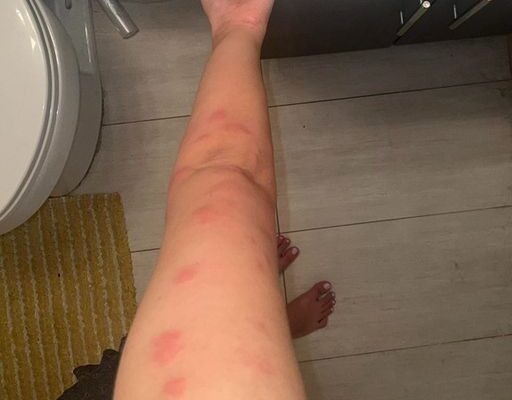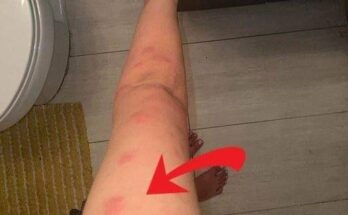
Bug Bite Identification: 10 Common Bug Bites With Pictures
Summer: the season of picnics, baseball games, and ice-cold lemonade on the back porch. But, with all of that outdoor time comes exposure to bugs, and the bites that go along with it. There are millions of bugs in our own backyards, and, sadly, it’s impossible to avoid every single one of them. That being said, we are able to minimize our risk of exposure and treat the bites that do occur naturally, so that we can go on enjoying our summer days with family and friends. Proper bug bite identification can help you find the right remedy for these annoying bites. In this article, we’ll help identify common bug bites using pictures and descriptions.
Common Bug Bites Identification
Bee Stings

Knowing what a bee sting looks like is an important bit of bug bite identification knowledge, especially if you or someone you love is allergic! Time is of the essence.
We often see the image of cute, fuzzy bees on children’s backpacks and coloring books, but these little bugs show us their not-so-cute side with their sting.
In order to sting, a bee stabs its barbed stinger into the skin. This stinger contains bee venom that contains proteins that affect skin cells and the immune system, causing pain and swelling to the sting area. Bees are only able to sting the victim once because their stinger becomes stuck inside of the skin[1].
You’re more likely to become stung if you are in close proximity to a beehive. Bees enjoy spending time near food, sweet drinks, and garbage cans, so be aware when you are spending time outdoors, particularly if you’re at a picnic or bar-be-que. Bees are also attracted to bright colors, so avoid wearing floral clothing if you plan to be outside for the day[1].
In most cases, bee stings are more of a nuisance than a serious medical concern, but some people may have a serious allergic reaction and require medical attention. If you begin experiencing signs of anaphylactic shock, seek medical attention immediately, as you may be experiencing an allergic reaction to bee venom.
All this being said, the bee population is shrinking at a dangerous pace! Keep a respectful distance, but please don’t kill bees or destroy beehives. Many beekeepers are happy to take a beehive off your hands safely.
Wasp stings

Wasps may look similar to bees, but they are considered to be slightly more menacing. A wasp is equipped with a stinger that is meant as a tool of self-defense. Just like a bee, a wasps stinger contains venom that, when injected into a human’s skin, will cause pain and swelling. The difference between a wasp and a bee is that a wasp is able to sting the victim multiple times because its stinger does not become lodged in the victim’s skin[2].
The majority of people without a wasp allergy will experience a sharp pain or burning at the site of the sting. Redness, swelling, and itching may also occur. For those with an allergy to a wasp sting, symptoms of anaphylaxis may occur, such as swelling of the face, throat, or lips, nausea, and a drop in blood pressure[2].
Like bees, wasps live in a hive, so if there is a hive nearby you can be sure that there will be wasps. Queen wasps typically build small nests in the spring to lay their eggs, and by mid-summer, the nests can reach a considerable size (some even as big as a basketball)[3]. Wasps like to hang out in well-populated areas and are commonly seen in and around garbage cans and picnic sites.
Mosquito bites

One of the more common bug bites – anyone who has ever been camping in the summer will be able to tell you what a nuisance mosquitos are. Mosquitos are a member of the fly family. The lifespan of mosquitoes is short (1 week for males and 1 month or more for females) but in that time they can manage to wreak havoc for humans[4].
Mosquitos like to live in the tall grass close to areas that humans inhabit. Standing water is their favorite breeding ground, so beware of bird baths, clogged rain gutters, pools, ponds, or any body of water that isn’t moving[4].
Mosquitos live off of nectar and water, but female mosquitos also need blood in order to reproduce, which is why they will bite animals[4]. The bite will typically leave you with a red, itchy welt for a couple of days.
The real problem with mosquitos is in their ability to spread diseases between animals and humans, as well as between multiple humans.
Flea bites

Most people tend to associate fleas with our furry canine friends, but fleas also like to bite us, humans, as well. Fleas are tiny bugs that can be very difficult to get rid of. They get around by jumping from place to place, and they multiply very quickly, which is why people often have a hard time removing them from their house[6].
If a flea bites you you’ll experience little red bites, usually around the ankle or legs, in groups of three or four. The skin around the bite will become very itchy, sore, or painful. It’s important to fight the urge to scratch because this will only damage the skin and cause a secondary infection to occur[6].
Because fleas cannot fly, they get around by jumping from place-to-place. They are associated with dogs because a flea can easily jump from dog to dog as they are playing. Fleas also hang out in long grass waiting for a victim to cling to.
Tick bites

Ticks like to wait for their victim in long grass, trees, shrubs, and leaf piles. Their bite is often harmless, and they typically don’t cause any noticeable symptoms, but they can be dangerous, and even deadly, by passing on diseases between animals and humans.
Ticks typically prefer warm, moist areas of the body (think armpit or groin area), and, while you may not experience any symptoms, is it possible to spot the tick and remove it[5]. Below is a short video on how to remove a tick safely.
Ant bites and stings

Fire ants get their name from the pain that their sting inflicts on its victims. Fire ants live in mounds or nests that are about 1 foot high, and they love grassy areas like pastures and lawns. Fire ants get very aggressive when an intruder disturbs their nest, and they will attack with repetitive stings as a group[6].
The bite of a fire ant will turn into yellowish blisters or red pustules that are raised with a red base. These bites will be itchy and painful and will expel a clear liquid after bursting. These bites will heal themselves over time, but they can be extremely painful at the moment that they occur[6].
Identifying lice

Lice are not just a bug that affects elementary school children, it can disturb each and every one of us! There are three kinds of lice that feed on human blood: head lice, pubic lice, and body lice. Head and pubic lice use the skin and hair as a nesting ground and body lice live on fabric.
Live don’t jump or fly, they crawl, and because of this, they are typically spread through the physical contact of one who is infected with lice[8]. This is why lice are common is school children, because children are constantly playing with each other, allowing lice to move from one child to the other.
The bite of a louse is small, red, and is often very itchy. The lice itself is often visible under close inspection. When scratched the bites can become infected, so avoid scratching as much as possible and work towards curing yourself of these menacing bugs using lice treatment.
What do bed bug bites look like?

Knowing what a bed bug bite looks like is an important bit of bug bite identification. These bugs invade your bed, your clothes, your furniture, and are tough to get rid of!
“Goodnight, sleep tight, don’t let the bedbugs bite” is a comedic little jingle that children like to say before drifting off to sleep, but in reality, bed bugs are anything but comical. These little bugs live in your furniture, feast on your blood, and once they’re there they are very difficult to get rid of.
These insects are extremely shy and typically come out at night in order to feast (which is where the nighttime jingle came from). They have a mouthpart that is dissected into two, one part that secretes saliva into the human and the other that feeds off of the human’s blood[9].
An individual’s response to a bed bug bite varies, but typically the bite appears as a very small, red, itchy bump on the body. A bite from a bed bug will go away on its own, but it is very difficult to rid your home of bed bugs once you have them, and the bugs are able to spread diseases between humans[9].
Spider bites

Spiders are everywhere. Whether we see them on a daily basis or not, they live both outside and inside of our homes. Often times we won’t notice when a spider bites us until after the fact. When we do notice, though, we will typically see a small, red welt on the skin where the spider bit, injecting its venom. This bite could be itchy or painful and may cause swelling[10].
Deer fly bites
Last on our bug bite identification list are deer flies. Deer flies are pesky little bugs with a painful bite. Deer flies are most active in the spring, and they like to live around lakes, swamps, and other bodies of water.
The bite of a deer fly will cause red bumps or welts on the skin. They can transmit a rare disease known as rabbit fever, whose symptoms include skin ulcers, fever, and headache[11].
Whether we like it or not, there will always be bugs around us, especially if we plan on enjoying any outdoor time. So, instead of trying to get rid of bugs completely, the best that we can do is minimize our chances of getting bit by avoiding places that these bugs are more likely to populate and heal any bites that we do happen to get naturally and safely.
Here are some ways that you can soothe your bug bite symptoms naturally:
Natural Bug Bite Relief
Essential Oils
Essential oils like tea tree and lavender have properties that alleviate itching, swelling, and irritation. Tea tree oil is also an antibacterial which can help prevent infection from scratching. These oils can be applied directly to the skin, or diluted with water or coconut oil[12]. Peppermint and camphor essential oils have a calming effect thanks to their menthol content.
Aloe Vera for bug bites
Aloe vera’s not just for sunburns! Cut an aloe vera leaf and apply the natural gel to the affected bug bite (and avoid the urge to itch).
Tea Bag Soak
Place a soaked cold tea bag on the affected area, the compounds in the tea will help with inflammation, while its coolness will help with the itch [12].
Sources
- “Bee Sting.” Mayo Clinic. Mayo Clinic Staff.
- “Wasp Stings: Reaction Symptoms and Treatment.” Healthline. Erica Roth. June 28, 2017.
- “Signs of Wasp Nest.” JCEhrlich.
- “Mosquito Bite Symptoms and Treatments.” Healthline. Ann Pietrangelo. July 7, 2016.
- “Tick Bites: Symptoms and Treatments.” Healthline. Kimberly Holland. May 24, 2017.
- “ Is It a Fleabite?: Symptoms and Treatments.” Healthline. Kimberly Holland. May 26, 2015.
- “Ant Bites.” STD. April 19, 2017.
- “A Close Look at Lice Bites.” Healthline. Elea Carey. January 11, 2017.
- “Bed Bug Bites.”Bed Bugs.
- “How to Identify and Treat Spider Bites.” Healthline. Colleen M. Story. October 20, 2016.
- “Types of Fly Bites, Symptoms, and Treatment.” Healthline. Ann Pietrangelo and Ana Gotter. March 17, 2017.
- “9 Genius Ways To Relieve Bug Bites.” Womenshealthmag. Kenny Thapoung. June 12, 2014.



